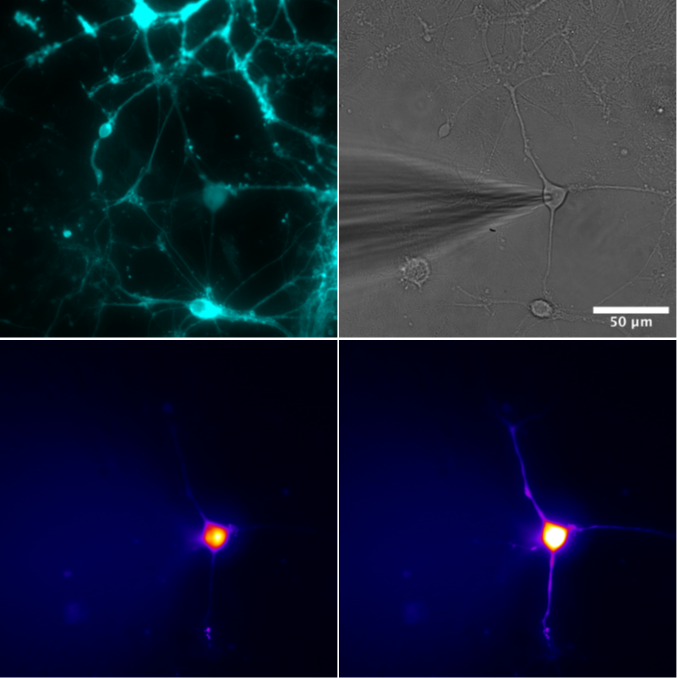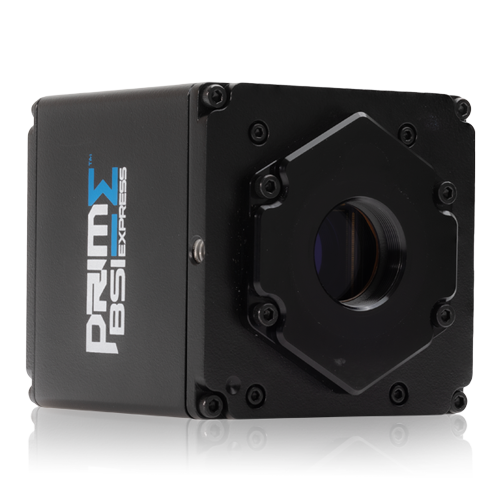Optogenetic Calcium Imaging and Electrophysiology
Dr. Benjamin Rost, Prof. Dietmar Schmitz, Prof. Peter Hegemann
GERMAN CENTRE FOR NEURODEGENERATIVE DISEASES (DZNE), CHARITE BERLIN, GERMANY
Background
Dr. Benjamin Rost is a senior scientist at the German Center for Neurodegenerative Diseases (DZNE) in Berlin and describes his research as follows, “I am interested in creating and applying new molecular tools to investigate signaling cascades underlying synapse function. Deciphering these pathways will allow us to understand how neurons communicate in the brain under physiological and pathological conditions. I develop novel optogenetic tools, and by combining optogenetic actuators and genetically encoded fluorescent indicators, I can modulate and image neuronal activity with light.”
In a recent collaboration with Prof. Peter Hegemann from Humboldt University Berlin, Dr. Rost combined electrophysiology and live-cell calcium imaging to characterize newly developed calcium-permeable channelrhodopsin (ChR) variants in hippocampal neurons. Light-sensitive ChRs are vital for optogenetics, and developing ChRs with a selectivity for calcium ions (Ca2+) has the potential to be a highly impactful tool for neuroscience. Dr. Rost and colleagues from Charité and Humboldt Universities have recently published their work in Nature Communications, demonstrating a major step forward for understanding Ca2+ interactions with ChR, and empowering neuroscientists with new tools (Fernandez Lahore et al 2022).

Figure 1: Optogenetics, calcium imaging, and electrophysiology of primary hippocampal neurons, acquired using the Prime BSI Express. Top left: neurons transduced with AAVs encoding ChRs fused to YFP. Top right: Cal-630 is perfused into neurons using a patch pipette. Bot left: Cal-630 baseline fluorescence after 630 nm excitation. Bot right: imaging with 630 and 470 nm flashes to see increased Cal-630 fluorescence indicating robust calcium influx due to ChR activity.
Challenge
The combination of optogenetics and electrophysiology brings unique challenges to this neuroscience application, which Dr, Rost outlines, “We need to perform whole-cell patch clamp experiments using brightfield illumination, followed by imaging of faint calcium signals at a reasonable speed, with minimal noise.”
Optogenetics requires high speed, high sensitivity fluorescence microscopy in order to image dynamic activity, and in this case the transport of calcium ions. On the other hand, electrophysiology benefits from a high-resolution camera with a large field of view, as individual neurons need to be selected from dense networks and carefully patch-clamped with a micro-pipette.
Dr. Rost further explained his experimental process, “We used the calcium indicator Cal-630 with neurons previously transfected with ChRs fused to YFP. This means we used 630 nm light for excitation of Cal 630 and 470 nm for excitation of the ChR, so we needed a camera that was synched to the excitation.”
This application needs a camera that is sensitive enough to image with a high quantum efficiency across a broad range. This is all done with low exposure times, meaning a low read noise is also required in order to capture the signal while imaging at the desired speed.
The Prime BSI Express is extremely useful for combining electrophysiology and imaging of our primary neurons. Thanks to the high sensitivity of the camera, we could readily detect changes in Ca2+ indicator signal.
Dr. Benjamin Rost
Solution
The Prime BSI Express is an ideal solution for neuroscience applications, featuring high sensitivity thanks to a combination of 95% peak quantum efficiency that extends over a broad spectral area, and 1 e- of read noise for low noise contributions. The Prime BSI Express can also image at 95 fps for capturing dynamic functional activity, and all across a 19 mm field of view.
The Prime BSI Express also features advanced hardware triggering capabilities, allowing for synchronisation with multiple light sources at different exposure times and with staggered timings. As well as flexible hardware, the Prime BSI Express has flexible software options, with full control available in Micro-Manager.
Overall, the Prime BSI Express is a great option for Dr. Rost’s work, having widespread usage across optogenetics, calcium imaging and electrophysiology, a truly proven solution.
Reference
Fernandez Lahore R.G., Pampaloni N.P., Peter E., Heim M.M., Tillert L., Vierock J., Oppermann J., Walther J., Schmitz D., Owald D., Plested A.J.R., Rost B.R., and Hegemann P (2022) Calcium-permeable channelrhodopsins for the photocontrol of calcium signaling. Nat Commun 13, 7844 https://doi.org/10.1038/s41467-022-35373-4
